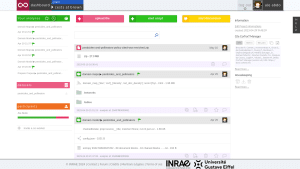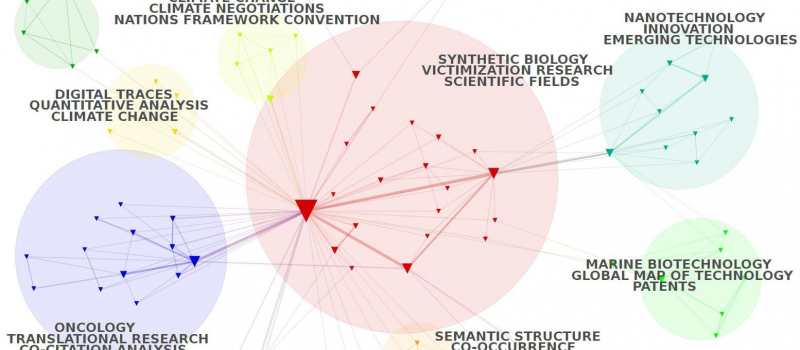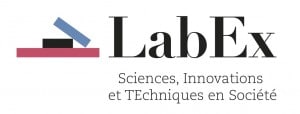Cortext platform
At Cortext, our goal is to empower researchers in the social sciences and humanities by promoting advanced qualitative-quantitative mixed methods. Our primary focus is on studies about the dynamics of science, technology and innovation, and about the roles of knowledge and expertise in societies.
We understand the move towards digital humanities and computational methods not as addressing a technological gap for the social sciences, but rather as entailing entirely new assemblages between its disciplines and those of modern statistics and computer sciences. We work to tackle ever more complex research problems and deal with the profusion of new and diverse sources of information without losing sight of the situatedness and reflexivity required of studies of human societies.
Cortext is hosted by the LISIS research unit at Gustave Eiffel University, and was launched by French institutes IFRIS and INRAE, receiving their continued support.
Cortext Manager

You upload a textual corpus in order to analyse its discourse, names, categories, citations, places, dates etc, with methods for science/controversy/issue mapping, distant reading, document clustering, geo-spatial and network visualizations, and more.
You can jump straight to Cortext Manager and create an account, but we strongly suggest taking a look at the Documentation and Tutorials as you start your journey.
Latest journal articles employing our instruments
Journal Articles
2022
Rikap, Cecilia
Becoming an intellectual monopoly by relying on the national innovation system: the State Grid Corporation of China's experience Journal Article
In: Research Policy, vol. 51, no. 4, pp. 104472, 2022, ISSN: 0048-7333.
@article{Rikap2022,
title = {Becoming an intellectual monopoly by relying on the national innovation system: the State Grid Corporation of China's experience},
author = {Cecilia Rikap},
url = {https://www.sciencedirect.com/science/article/pii/S004873332100264X},
doi = {10.1016/j.respol.2021.104472},
issn = {0048-7333},
year = {2022},
date = {2022-05-01},
urldate = {2022-05-01},
journal = {Research Policy},
volume = {51},
number = {4},
pages = {104472},
abstract = {This paper examines the origins of global leaders under intellectual monopoly capitalism. State Grid Corporation of China (SGCC), the leading firm in artificial intelligence applications for the energy sector, became an intellectual monopoly relying heavily on China's national innovation system –particularly public research organizations and public funding, and innovation and energy policies. SGCC is unique because it did not rely on technology transfer from global leaders, unlike other national champions from developing or emerging countries. We provide evidence that contributes to thinking that SGCC first became a national intellectual monopoly and only afterwards expanded that monopoly globally. We empirically study SGCC's innovation networks. We proxy them using big data techniques to analyze the content, co-authors and co-owners of its publications and patents. Results also suggest that SGCC is capturing intellectual rents from its increasingly transnational and technologically diverse innovation networks by leveraging its national innovation system.},
keywords = {},
pubstate = {published},
tppubtype = {article}
}
Maniquiz-Redillas, Marla; Robles, Miguel Enrico; Cruz, Gil; Reyes, Nash Jett; Kim, Lee-Hyung
First Flush Stormwater Runoff in Urban Catchments: A Bibliometric and Comprehensive Review Journal Article
In: Hydrology, vol. 9, pp. 63, 2022.
@article{Maniquiz-Redillas2022,
title = {First Flush Stormwater Runoff in Urban Catchments: A Bibliometric and Comprehensive Review},
author = {Marla Maniquiz-Redillas and Miguel Enrico Robles and Gil Cruz and Nash Jett Reyes and Lee-Hyung Kim},
url = {https://mdpi-res.com/d_attachment/hydrology/hydrology-09-00063/article_deploy/hydrology-09-00063-v2.pdf?version=1649637354},
doi = {10.3390/hydrology9040063},
year = {2022},
date = {2022-04-09},
urldate = {2022-04-09},
journal = {Hydrology},
volume = {9},
pages = {63},
abstract = {First flush is a phenomenon in stormwater runoff that has been considered a topic of great interest in the field of nonpoint source pollution. Despite several attempts to define the first flush quantitively, the specified characteristics of the phenomenon vary among sources. To address these uncertainties, a bibliometric and comprehensive review on published articles related to first flush was conducted. A corpus of 403 research articles was obtained from the Scopus database, which was then parsed using the CorText Manager for the bibliometric analysis. The study examined quantitative definitions of first flush from various sources; climate and topographic characteristics of monitoring and experimental sites where the studies on first flush were performed; the sample collection methods applied; the first flush values obtained on the studies and how it influenced the nonpoint source pollution in urban watersheds. A network map, two contingency matrices, and a Sankey diagram were created to visualize the relationship of significant keywords related to first flush, as well as their co-occurrences with journals, countries, and years. It was found that the strength of the first flush effect could vary depending on the geographical location of the site, climatic conditions, and the pollutants being analyzed. Therefore, initial rainfall monitoring, runoff sampling, and water quality testing were seen as critical steps in characterizing the first flush in urban catchments. Furthermore, the characterization of first flush was found to be significant to the selection of best management practices and design of low-impact development (LID) technologies for stormwater runoff management and nonpoint source pollution control.},
keywords = {},
pubstate = {published},
tppubtype = {article}
}
Calvo, Diana C.; Luna, Hector J.; Arango, Jineth A.; Torres, Cesar I.; Rittmann, Bruce E.
Determining global trends in syngas fermentation research through a bibliometric analysis Journal Article
In: Journal of Environmental Management, vol. 307, pp. 114522, 2022, ISSN: 0301-4797.
@article{Calvo2022,
title = {Determining global trends in syngas fermentation research through a bibliometric analysis},
author = {Diana C. Calvo and Hector J. Luna and Jineth A. Arango and Cesar I. Torres and Bruce E. Rittmann},
url = {https://www.sciencedirect.com/science/article/pii/S0301479722000950},
doi = {10.1016/j.jenvman.2022.114522},
issn = {0301-4797},
year = {2022},
date = {2022-04-01},
journal = {Journal of Environmental Management},
volume = {307},
pages = {114522},
abstract = {Syngas fermentation, in which microorganisms convert H2, CO, and CO2 to acids and alcohols, is a promising alternative for carbon cycling and valorization. The intellectual landscape of the topic was characterized through a bibliometric analysis using a search query (SQ) that included all relevant documents on syngas fermentation available through the Web of Science database up to December 31st, 2021. The SQ was validated with a preliminary analysis in bibliometrix and a review of titles and abstracts of all sources. Although syngas fermentation began in the early 1980s, it grew rapidly beginning in 2008, with 92.5% of total publications and 87.3% of total citations from 2008 to 2021. The field has been steadily moving from fundamentals towards applications, suggesting that the field is maturing scientifically. The greatest number of publications and citations are from the USA, and researchers in China, Germany, and Spain also are highly active. Although collaborations have increased in the past few years, author-cluster analysis shows specialized research domains with little collaboration between groups. Based on topic trends, the main challenges to be address are related to mass-transfer limitations, and researchers are starting to explore mixed cultures, genetic engineering, microbial chain elongation, and biorefineries.},
keywords = {},
pubstate = {published},
tppubtype = {article}
}
Taxt, Randi Elisabeth; Robinson, Douglas K. R.; Schoen, Antoine; Fløysand, Arnt
The embedding of universities in innovation ecosystems: The case of marine research at the University of Bergen Journal Article
In: Norsk Geografisk Tidsskrift–Norwegian Journal of Geography, vol. 76, iss. 1, pp. 42–60, 2022, ISSN: 0029-1951.
@article{Taxt2022,
title = {The embedding of universities in innovation ecosystems: The case of marine research at the University of Bergen},
author = {Randi Elisabeth Taxt and Douglas K.R. Robinson and Antoine Schoen and Arnt Fløysand},
url = {https://www.tandfonline.com/doi/pdf/10.1080/00291951.2022.2041718},
doi = {10.1080/00291951.2022.2041718},
issn = {0029-1951},
year = {2022},
date = {2022-03-06},
urldate = {2022-03-06},
journal = {Norsk Geografisk Tidsskrift–Norwegian Journal of Geography},
volume = {76},
issue = {1},
pages = {42–60},
abstract = {While historically the core missions of universities have been research and teaching, it has become increasingly recognised that universities have become significant sources of knowledge and capabilities. This third mission is cementing the role of universities as suppliers of qualified labour and generators of knowledge and technologies that promote innovation in a variety of innovation ecosystems. The main goal of the paper is to illustrate an approach that captures the various contributions of universities to their innovation ecosystems. Often territorially bounded, such links provide insights into the characteristics and geography of the various linkage for a university. With the case of the University of Bergen and its role within the marine innovation ecosystem of Western Norway, this ‘ecosystem fingerprint’, can be seen as a useful means to clarify the third mission of universities through the linkages and interdependencies with various actors. The authors demonstrate that a university can act both as a global pipeline provider and take active part in the local buzz, providing this concept with new empirical insight. The authors conclude that the university is highly embedded in both the marine innovation ecosystem and the knowledge ecosystem, but with linkages extended to interconnected business ecosystems.},
keywords = {},
pubstate = {published},
tppubtype = {article}
}
NotesVIEW ALL
-
Long trends on twitter: intertemporal clusters combining hashtags and terms on Scientometrics, Altmetrics, Bibliometrics and Science Of Science
Long trends on twitter: inter-temporal clusters combining hashtags and terms, for all tweets on Scientometrics, Altmetrics, Bibliometrics and Science Of Science from Jan. 2017 to dec. 2021, on a semester base. Query used to extract tweets: lang:en (Scientometrics OR “ScienceOfScience” OR “Science Of Science” OR “Altmetrics” OR “altmetric” OR “bibliometrics” OR “bibliometric” OR “citation metrics” […]
-
Présenter CorTexT Manager en 2 minutes
Cortext Manager est une application web construite par des chercheurs et par des ingénieurs à destination de chercheurs en sciences humaines et sociales, au plus près des questions portées par les chercheurs qui nous entourent et par notre communauté d’utilisateurs. Cette application web peut produire un grand nombre d’analyses différentes qui ont trait aux champs […]
-
Analysis of the scientific production that mentioned the use of CorText Manager
There are two ways to understand what CorTexT Manager is. The first one is to look at what has been achieved in terms of methods, tools and therefore lines of code. The second one is studied below, by analyzing (here with CorTexT Manager) what academic users have published using… CorTexT Manager. Our study of the […]
-
10 years of CorText Manager v2
It took us more than 10 years to come with CorText Manager version 2 as it is now! Behind the scenes CorText Manager begun with a first version in 2009. More than thirty contributors has worked directly or indirectly on the two versions, year after year. All the ideas, inspirations, all this accumulation of pieces […]
-
RISIS Training: Thematic and spatial analysis of technologies using CorText Manager and RISIS patent database
One of the best CorText Manager training courses was organized and offered by the RISIS project. Here is the program of this training which lasted 3 days: Monday 08/11/21 14h-16h30: Session 1 Session 1a: Introduction on patent analysis (60’) Introductory lecture session • Welcoming introduction (Philippe Larédo) 5’ • Type of patents documents (Antoine Schoen) […]
-
Early 2021 CorText Manager training sessions
CorText organized a series of training workshops on CorText Manager and its methods in January 2021! These workshops were imagined as a staircase with three successive steps : Session 1: Introduction Session 2: Method comparisons Session 3: Research questions and work on user’s corpus For these sessions, the subject chosen for the demonstrations and exercises […]
-
Seminar and workshop during the Summer School of PPGCI IBICT UFRJ, Rio de Janeiro – 03/2020
In March 2020, the LabEx SITES post-doctoral researcher, Ale Abdo, traveled to Rio de Janeiro and São Paulo to organize two trainings on textual analysis and on a new method he developed and integrated at the CorText Infrastructure, as well as to participate in discussions on open and citizen science in Brazil, including the discussion […]
-
A CorText Manager distance training session in the framework of the nanocellulose project – Grenoble, June 2020
For complementing the RISIS access requested (to Leiden publications DB and RISIS patent DB) by the GAEL laboratory (UMR INRAE, CNRS, UGA, INPG), in the framework of a research project on nanocellulose, the CorText team has provided , in June and July 2020, an advanced training on the use of CorText. After setting up of […]
CorText Newsfeed
Want to stay up-to-date with the latest training sessions and developments in our methods and data? We invite you to subscribe to Cortext Newsfeed, our succint and researcher oriented quarterly newsletter.
Read the previous editions of our newsletter








